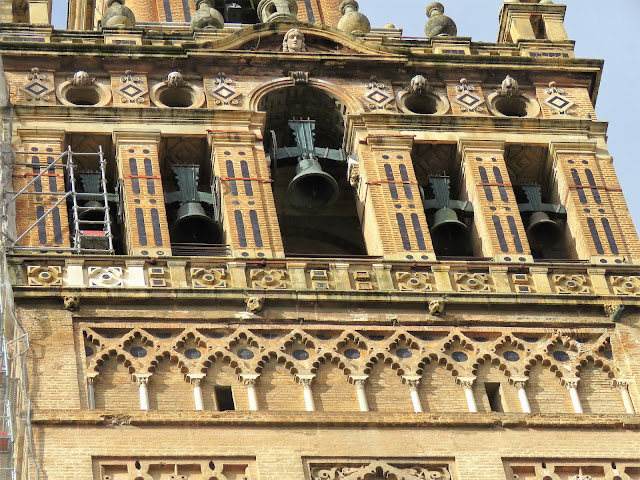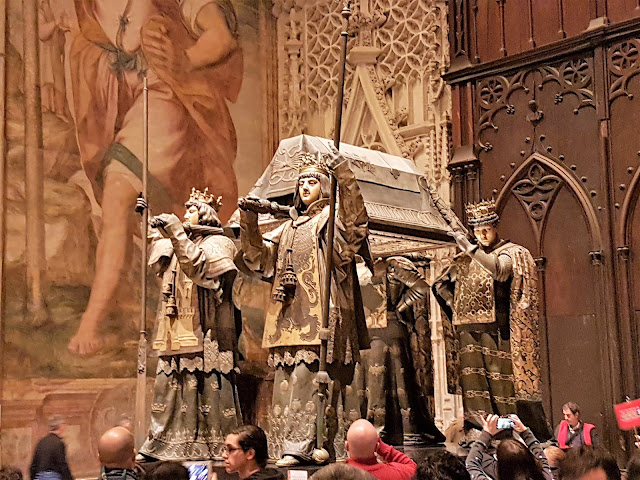November 2018 - Seville Spain
Click here for our full day in Seville including some amazing photos taken from the Cathedral tower. There are also links to some other world famous churches!!
Seville's cathedral, Santa Maria de la Sede, is the largest Gothic cathedral in the world, and is recognised as UNESCO World Heritage.
The cathedral's construction lasted over a century, from 1401 to 1506. It is said that when the plans were drawn up, church elders stated, "Hagamos una iglesia tan hermosa y tan grandiosa que los que la vieren labrada nos tengan por locos." (Let us build a church so beautiful and so magnificent that those who see it finished will think we are mad).
The basilica occupies the site of the great Aljama mosque, built in the late 12th century by the Almohads, the ruling Moorish dynasty, of which the only remaining parts are the Patio de Naranjas, the Puerta del Perdon (on Calle Alemanes, on the north side), and the Giralda (formerly the minaret, now the belltower).
The square around the cathedral is a photo opportunity.
The stuffed crocodile, known as El Lagarto was a gift from the Sultan of Egypt to King Alfonso X, for asking for the hand in marriage of his daughter Berenguela. Although the Sultan did not wed the princess in the end, the crocodile stayed, and was stuffed. Now it is one of the cathedral's quirkier relics.
Its central nave rises to an awe-inspiring 42 metres and even the 80 side chapels each seem tall enough to contain an ordinary church. The total area covers 11,520m2 and according to some, new calculations, based on cubic measurements, have now pushed it in front of St Peter's in Rome and the Catedral Metropolitana Nossa Senhora Aparecida in Brazil as the largest church in the world. But this is still a subject for debate, and many claim it is still the third-largest in the world.
Sheer size and grandeur are, inevitably, the chief characteristics of the Cathedral, although two other qualities stand out with equal force - the rhythmic balance and interplay between the parts, and an impressive overall simplicity and restraint in decoration (apart from the Retablo Mayor). All successive ages have left monuments of their own wealth and style, but these have been restricted to the two rows of side chapels. In the main body of the cathedral only the great box-like structure of the coro (choir) stands out, filling the central portion of the nave.
.
THE TOMB OF CHRISTOPHER COLUMBUS
This is one of the main attractions of the cathedral for visitors, housing the remains of the great explorer who died in poverty in Valladolid. The tomb itself is more recent, from the 1892, with four bearers presenting the kingdoms of Castile, Leon, Aragon and Navarra.
PATIO DE LOS NARANJOS
You walk through this large courtyard contained within the cathedral precinct as you leave the cathedral. The Patio de los Naranjos dates back to Moorish times when worshippers would wash their hands and feet in the fountains here - under the orange trees - before their five daily prayer sessions.


















































...gorgeous, but a bit too much!
ReplyDeleteMagnificent.
ReplyDeleteThat is one amazing Cathedral
ReplyDeleteAwesome post! They have a bit of everything, sublime to ridiculous.
ReplyDeleteVery impressive!
ReplyDelete